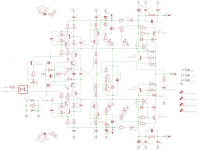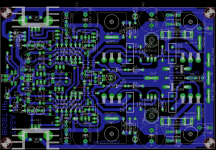About Tantalum, they are not so bad for signal too, as long as they are polarized with enough voltage margin. More fluid than Aluminum, on my feelings.
I have never had a good experience with tantalum. Yes they have that clean character (or whatever audiophile term suitable for that) but what I'm looking for is a sound that will grab my attention and make me absorbed into the music. Tantalum is just not it. May be it is more suitable for digital circuitry like the Sanyo Oscon.
but they may have one serious problem, they are not so great looking
Yes they are looking same as cheap bad no name caps........
Marc
Yes they are looking same as cheap bad no name caps........
but their 'specs' may not be 'trust worthy'
I suppose Panasomic's can specs can ...wow, that was twisted 😀
but +3amp ripple current is quite good for a small sized 50V 12x25 cap, no ?
one hatch though, 50V is max
I think FRs are supposed to be an improvement on the FMs (which were already better than the FCs). Thus there will be some uF/V values that won't be available in the FR/FM range so one will have to resort to the "lesser" FC range.
.... just about their outside look
Marc
we choose by the looks, from the day of birth 😛
its our nature, no point in denying it
phenomenal.
For serving the TLP627. : Confused:
please do not find the link for the latest design PCB.Que Idefixes performed with the help of Lazy Cat.😕
please do not find the link for the latest design PCB.Que Idefixes performed with the help of Lazy Cat.😕
See attached.
Marc
Attachments
thanks friend
Thanks, many thanks. Do not have it in PDF format. to do with the method of the plate.
: D
See attached.
Marc
Thanks, many thanks. Do not have it in PDF format. to do with the method of the plate.
: D
Last edited:
TLP627 is opto device remoted by DC detection on OUTput. The whole effect is to shutdown output stage when DC is present.
The design is not fully tested for moment (missing time). Before etching plate are you shure to be able to purchase all matched need transistor in BIGBT module (NPN/PNP and mosfet) but all little and middle transistors too in first stage?
Marc
The design is not fully tested for moment (missing time). Before etching plate are you shure to be able to purchase all matched need transistor in BIGBT module (NPN/PNP and mosfet) but all little and middle transistors too in first stage?
Marc
Other than the TLP627, I have everything in my large parts collection; JFETs are similar, eg., 2N5461 instead of 5462. So will a PDF of the track pattern be made available please? Thanks.
TLP627 is opto device remoted by DC detection on OUTput. The whole effect is to shutdown output stage when DC is present.
The design is not fully tested for moment (missing time). Before etching plate are you shure to be able to purchase all matched need transistor in BIGBT module (NPN/PNP and mosfet) but all little and middle transistors too in first stage?
Marc
What?
Other than the TLP627, I have everything in my large parts collection; JFETs are similar, eg., 2N5461 instead of 5462. So will a PDF of the track pattern be made available please? Thanks.
May be in private but at your own risk as i don't want to publish something public that not be tested
Marc
Other than the TLP627, I have everything in my large parts collection; JFETs are similar, eg., 2N5461 instead of 5462. So will a PDF of the track pattern be made available please? Thanks.
Hi Samuel
2N5461 is conditionally acceptable because it could have too low Vgs at demanded CCS current, so cascoded BJT's Vce=Vgs would not have enough headroom to operate properly. I suggest you to use 2N5462 or two 2N5461 in parallel. 😉
Hi Samuel
2N5461 is conditionally acceptable because it could have too low Vgs at demanded CCS current, so cascoded BJT's Vce=Vgs would not have enough headroom to operate properly. I suggest you to use 2N5462 or two 2N5461 in parallel. 😉
Thanks for that info. Might as well order for 2N5462 from Element14 (formerly Farnell) as well as all the JFETs required for Sonya's version of the TSSA.
Try to listen with the feedback bypass caps completely removed first.
From stability point of view it is okay as Rf is not alteret.
How do you describe the Sound after some days og use?
What about salas? What do you Think ?
The 200kHZ square waves pics are with no bypasses at all. Not on rails, not on feedback. Perfectly stable. I don't know if the bypasses speed it up more, but with just the FC lytics, I found the -3dB point at circa 2.5MHZ (6 vertical divisions reduced to 4 rough check point).
I believe it is better that way: a light low pass filter induced by the lytic inductance is better than any ringing.From stability point of view it is okay as Rf is not alteret
And, as long open loop bandwidth and slew rate remains unchanged, we don't need zillion htz of closed loop bandwidth.
Last edited:
From stability point of view it is okay as Rf is not alteret.
How do you describe the Sound after some days og use?
What about salas? What do you Think ?
Sound is really nice, I think the best amp ever listened.
Changed the feedback resistors to 50R from 100R to have a little bit more gain. Seems better on the lower gain but I am not sure. Maybe try with 75R and see.
- Home
- Amplifiers
- Solid State
- TSSA - The Simplest Symmetrical Amplifier


